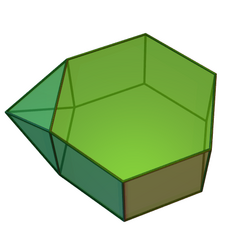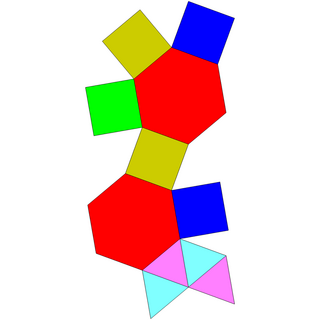Augmented hexagonal prism
From HandWiki
Short description: 54th Johnson solid
| Augmented hexagonal prism | |
|---|---|
 | |
| Type | Johnson J53 – J54 – J55 |
| Faces | 2x2 triangles 1+2x2 squares 2 hexagons |
| Edges | 22 |
| Vertices | 13 |
| Vertex configuration | 2x4(42.6) 1(34) 4(32.4.6) |
| Symmetry group | C2v |
| Dual polyhedron | monolaterotruncated hexagonal bipyramid |
| Properties | convex |
| Net | |
 | |
In geometry, the augmented hexagonal prism is one of the Johnson solids (J54). As the name suggests, it can be constructed by augmenting a hexagonal prism by attaching a square pyramid (J1) to one of its equatorial faces. When two or three such pyramids are attached, the result may be a parabiaugmented hexagonal prism (J55), a metabiaugmented hexagonal prism (J56), or a triaugmented hexagonal prism (J57).
A Johnson solid is one of 92 strictly convex polyhedra that is composed of regular polygon faces but are not uniform polyhedra (that is, they are not Platonic solids, Archimedean solids, prisms, or antiprisms). They were named by Norman Johnson, who first listed these polyhedra in 1966.[1]
External links
 |
- ↑ Johnson, Norman W. (1966), "Convex polyhedra with regular faces", Canadian Journal of Mathematics 18: 169–200, doi:10.4153/cjm-1966-021-8.

